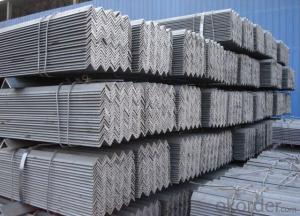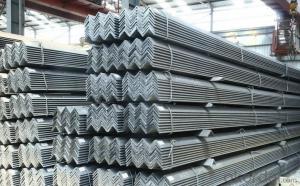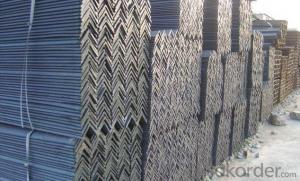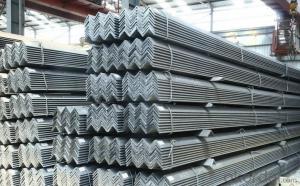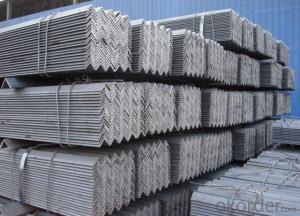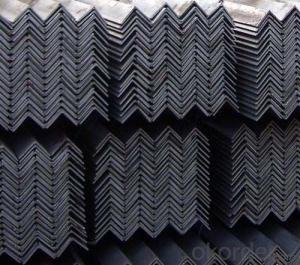Steel Equal Angle with Good Quality 125*125*8.0-14.0mm
- Loading Port:
- Tianjin
- Payment Terms:
- TT OR LC
- Min Order Qty:
- 50 m.t
- Supply Capability:
- 15000 m.t/month
OKorder Service Pledge
OKorder Financial Service
You Might Also Like
Specification
Product Description:
Specifications of Steel Equal Angle with Good Quality 125*125*8.0-14.0mm:
1. Invoicing on theoretical weight or actual weight as customer request
2. Length: 6m, 9m, 12m as following table
3. Sizes

| Size(mm) | Mass(Kg/m) | Size(mm) | Mass(Kg/m) |
| 125*125*8.0 | 15.504 | 125*125*12.0 | 22.696 |
| 125*125*10.0 | 19.133 | 125*125*14.0 | 26.193 |
Payment terms:
1).100% irrevocable L/C at sight.
2).30% T/T prepaid and the balance against the copy of B/L.
3).30% T/T prepaid and the balance against L/C
Material details:
Grade | Element (%) | ||||
C | Mn | S | P | Si | |
Q235 | 0.12—0.20 | 0.3—0.7 | ≤0.045 | ≤0.045 | ≤0.3 |
Usage & Applications of Steel Equal Angle with Good Quality 125*125*8.0-14.0mm:
According to the needs of different structures, Angle can compose to different force support component, and also can be the connections between components. It is widely used in various building structures and engineering structures such as roof beams, bridges, transmission towers, hoisting machinery and transport machinery, ships, industrial furnaces, reaction tower, container frame and warehouse etc.
Packaging & Delivery of Steel Equal Angle with Good Quality 125*125*8.0-14.0mm:
1. Packing: it is nude packed in bundles by steel wire rod
2. Bundle weight: not more than 3.5MT for bulk vessel; less than 3 MT for container load
3. Marks:
Color marking: There will be color marking on both end of the bundle for the cargo delivered by bulk vessel. That makes it easily to distinguish at the destination port.
Tag mark: there will be tag mark tied up on the bundles. The information usually including supplier logo and name, product name, made in China, shipping marks and other information request by the customer.
If loading by container the marking is not needed, but we will prepare it as customer request.
Production flow of Steel Equal Angle with Good Quality 125*125*8.0-14.0mm:
Material prepare (billet) —heat up—rough rolling—precision rolling—cooling—packing—storage and transportation
FAQ:
Q1: Why buy Materials & Equipment from OKorder.com?
A1: All products offered byOKorder.com are carefully selected from China's most reliable manufacturing enterprises. Through its ISO certifications, OKorder.com adheres to the highest standards and a commitment to supply chain safety and customer satisfaction.
Q2: How do we guarantee the quality of our products?
A2: We have established an advanced quality management system which conducts strict quality tests at every step, from raw materials to the final product. At the same time, we provide extensive follow-up service assurances as required.
Q3: How soon can we receive the product after purchase?
A3: Within three days of placing an order, we will begin production. The specific shipping date is dependent upon international and government factors, but is typically 1 to 2 months.
Q4: How many tons can be loaded into one 20ft container?
A4: Around 23—25tons
Images of Steel Equal Angle with Good Quality 125*125*8.0-14.0mm:

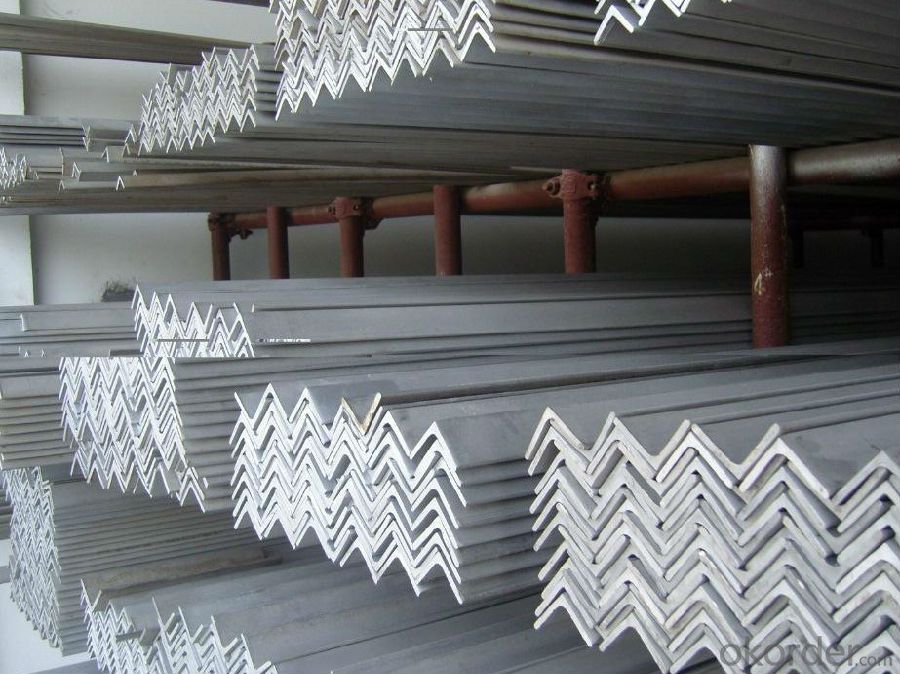
- Q: Can steel angles be used for electrical conduits or cable trays?
- Steel angles can be used for electrical conduits or cable trays depending on the specific requirements and regulations of the project. Steel angles are commonly used as structural supports and are known for their strength and durability. However, when considering their use for electrical conduits or cable trays, it is important to ensure that they meet the necessary electrical and safety codes. Electrical conduits and cable trays are designed to safely house and protect electrical wires or cables. These systems need to be able to withstand the weight of the cables, provide proper grounding, and offer adequate protection against physical damage or exposure to moisture or other hazards. Steel angles can be used as support structures for electrical conduits or cable trays, providing a sturdy framework for mounting and securing the system. However, it is crucial to ensure that the steel angles are properly grounded, insulated, and protected against corrosion to meet electrical safety standards. Additionally, the specific size and dimensions of the steel angles should be chosen based on the weight and size of the cables or wires being installed. It is important to consult with electrical engineers or professionals familiar with local electrical codes and standards to ensure that the steel angles meet all necessary requirements. In conclusion, steel angles can be used for electrical conduits or cable trays, but it is essential to consider the specific requirements and regulations of the project to ensure electrical safety and compliance.
- Q: Can steel angles be used for manufacturing safety barriers?
- Indeed, safety barriers can be manufactured using steel angles. In construction projects, steel angles are frequently utilized owing to their robustness and longevity. Specifically for safety barriers, they offer a firm framework that can endure impacts and offer protection. By welding or bolting steel angles together, a solid and secure barrier can be created effortlessly. Furthermore, by galvanizing or coating steel angles with anti-corrosive substances, their lifespan and resistance against environmental factors can be enhanced. In summary, steel angles are an exceptional option for manufacturing safety barriers due to their strength, durability, and versatility.
- Q: What are the common finishes available for steel angles?
- The common finishes available for steel angles include hot-dip galvanized, painted, and untreated/raw.
- Q: Can steel angles be used in the construction of government buildings?
- Yes, steel angles can be used in the construction of government buildings. Steel angles are commonly used in construction due to their strength, durability, and versatility. They are often used for structural support, framing, and reinforcement in various building projects, including government buildings.
- Q: What are the different types of steel angles used in construction?
- Construction commonly employs various types of steel angles, each serving distinct purposes. By bending steel into a 90-degree angle, an L-shape is formed. The following are the different steel angles regularly utilized in construction: 1. Equal angles: These angles possess identical lengths on both sides, creating a right angle. They find frequent usage in constructing frames, supports, and braces for various construction projects. 2. Unequal angles: These angles, as the name implies, have dissimilar lengths on each side. They are often employed when one side requires greater or lesser length than the other. Unequal angles are regularly used for structural support in buildings, bridges, and other infrastructure endeavors. 3. L-shaped angles: L-shaped angles possess a 90-degree bend but lack equal lengths on both sides. They are commonly utilized when a specific length is necessary on one side, such as creating shelves or brackets. 4. Rolled steel angles: Manufacturers produce these angles by passing a steel strip through a series of rollers, shaping it into the desired angle. Rolled steel angles are valued in construction projects for their strength and durability. 5. Stainless steel angles: These angles are crafted from a corrosion-resistant alloy, making them suitable for applications exposed to moisture or harsh environments. They are frequently implemented in construction projects that prioritize aesthetics and longevity, such as architectural structures or exterior cladding. 6. Galvanized steel angles: These angles are coated with a layer of zinc to safeguard against corrosion. Consequently, they are suitable for outdoor applications, where exposure to moisture or harsh weather conditions is likely. Galvanized steel angles are commonly used in construction projects like fences, handrails, or outdoor structures. In conclusion, construction employs a range of steel angles, encompassing equal angles, unequal angles, L-shaped angles, rolled steel angles, stainless steel angles, and galvanized steel angles. Each type possesses unique properties and applications, rendering them indispensable and versatile components in diverse construction projects.
- Q: How do you join two steel angles together?
- To join two steel angles together, there are several methods you can use depending on the specific application and requirements. Here are a few common techniques: 1. Welding: Welding is the most common method used to join steel angles. It involves heating the joint to a high temperature and melting a filler material, usually a compatible metal, to fuse the two angles together. This creates a strong and permanent bond. Welding requires specialized equipment and expertise, so it is typically done by trained professionals. 2. Bolting: Another method is to use bolts or screws to connect the two steel angles. This involves drilling holes through both angles and then securing them with appropriate fasteners. Bolting allows for easier disassembly and modification if needed. However, it may not provide the same level of strength as welding. 3. Riveting: Riveting is a technique that uses metal pins or bolts called rivets to hold the steel angles together. It involves drilling holes through the angles and inserting the rivets, which are then hammered or pressed to form a permanent joint. Riveting is commonly used in structural applications where high strength and load-bearing capacity are required. 4. Adhesive bonding: In some cases, adhesive bonding can be used to join steel angles. Specialized adhesives are applied to the joint surfaces, and then the angles are pressed together and left to cure. This method can provide a clean and aesthetically pleasing bond, but it may not be as strong as other mechanical methods. When selecting a method to join steel angles, it is important to consider factors such as the load-bearing requirements, structural integrity, accessibility, and the specific conditions of the application. Consulting with a structural engineer or a professional in the field can help determine the most suitable technique for your specific needs.
- Q: What does 50*50*5 angle mean?
- 50*50*5 angle means: the outer section of angle steel is 50mmx50mm, and the angle steel is 5mm.
- Q: What are the different types of steel angles used in staircases?
- There are several different types of steel angles that are commonly used in staircases. These angles serve different purposes and are chosen based on the specific requirements of the staircase design. 1. Equal Leg Angle: This is the most common type of steel angle used in staircases. It has equal length legs that form a 90-degree angle. These angles are typically used for structural support and are often found in the framework of the staircase. 2. Unequal Leg Angle: As the name suggests, unequal leg angles have legs of different lengths. These angles are used when one side of the staircase needs more support or when a certain aesthetic look is desired. They are commonly used in stair treads, risers, and stringers to provide stability and strength. 3. L-Shaped Angle: L-shaped angles are used for corner connections in staircases. They have one leg that extends straight and another that is perpendicular to it, forming an L shape. These angles are commonly used in stair handrails, balusters, and brackets to provide support and reinforcement at junctions. 4. Slotted Angle: Slotted angles are specially designed with slots along the length of the angle. These slots allow for easy adjustment and flexibility in the positioning of components in a staircase. They are often used for adjustable stair brackets, tread supports, and other elements that may require fine-tuning during installation. 5. Flat Bar Angle: Flat bar angles, also known as flat stock angles, are made from flat steel bars bent to form a right angle. These angles are used to provide additional support and reinforcement in staircases where extra strength is required. They are commonly used in heavy-duty stair applications or where there is a need for added load-bearing capacity. Overall, the choice of steel angle used in a staircase depends on factors such as load capacity, structural requirements, aesthetic considerations, and the specific design of the staircase. Consulting with a structural engineer or staircase designer can help determine the most suitable type of steel angle for a particular staircase project.
- Q: Can steel angles be used for stair stringers?
- Certainly, stair stringers can indeed utilize steel angles. Due to their robustness and resilience, steel angles are widely employed in the realm of construction. As stair stringers, steel angles provide the essential support and steadiness required for the stairs. They can be effortlessly trimmed and welded to the preferred shape and size, rendering them an adaptable choice for stair construction. Furthermore, steel angles possess resistance against decay, termites, and other types of harm, guaranteeing the durability of the stair structure. Nevertheless, it is imperative to seek guidance from a structural engineer or a professional contractor to ascertain that the steel angles conform to the specific criteria and weight-bearing capacity as per the intended stair design.
- Q: How do steel angles perform in terms of thermal expansion and contraction?
- Steel angles have a relatively low coefficient of thermal expansion, which means they expand and contract less compared to other materials when subjected to temperature changes. This property makes steel angles highly stable in terms of thermal expansion and contraction. Consequently, they are widely used in various structural applications where temperature variations are expected. Steel angles provide structural integrity and stability, even in environments with significant temperature fluctuations, making them a reliable choice for construction and engineering projects.
Send your message to us
Steel Equal Angle with Good Quality 125*125*8.0-14.0mm
- Loading Port:
- Tianjin
- Payment Terms:
- TT OR LC
- Min Order Qty:
- 50 m.t
- Supply Capability:
- 15000 m.t/month
OKorder Service Pledge
OKorder Financial Service
Similar products
Hot products
Hot Searches
Related keywords
